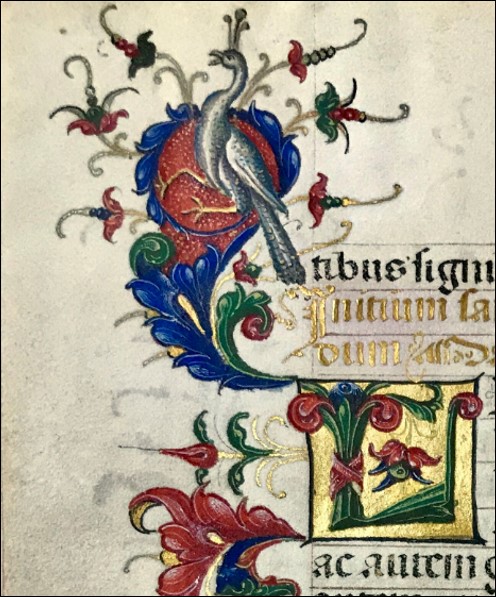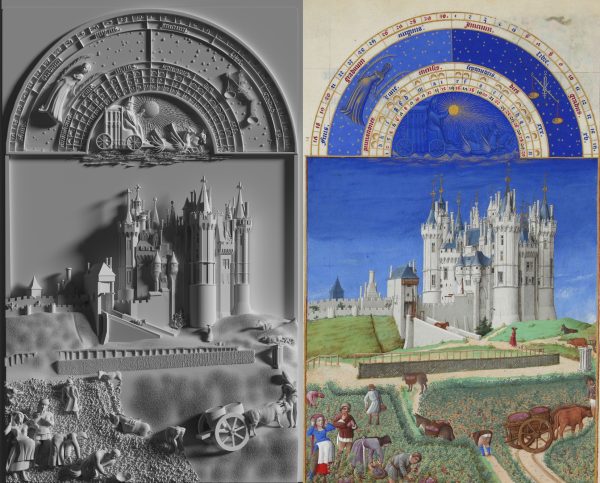With piped-in sounds and fragrant scents, the bird and flower illustrations of ornate manuscripts spring to life at the Museum Van Lymborch Brothers House. Thanks to the work of Kasteel Well art history students, these new sensory experiences will take center stage in a new exhibition at the museum dedicated to the medieval Dutch artists, the Van Lymborch Brothers.
The museum, located roughly 30 miles north of EmersonÔÇÖs Netherlands-based campus in the brothersÔÇÖ birth city of Nijmegen, explores the lives and works of the three artists, 15th-century miniature painters whose illuminated manuscripts are medieval marvels of intricate, florid details and color. Admired throughout history for their beauty and artisanship, this summerÔÇÖs gallery brings these treasured works to a new audience ÔÇô the visually impaired.
ÔÇťFeel Van LymborchÔÇŁ opened on May 11, implementing designs and ideas from Kasteel Well students to reexamine the works through the utilization of all five senses. The Van Lymborch Brothers House, a mix of renovated and preserved rooms in a former studio of the artists, is a small museum. As such, gaining access to the much-coveted original manuscripts, historically used for devotional books, is hard. Instead, their display usually features other manuscripts from their period and historical presentations.

The new exhibition aims to elevate the gallery by offering experiential opportunities for the visually impaired to engage with illuminated manuscripts. Its centerpiece is an interactive reconstruction of a medieval studio, complete with period-accurate materials. This will be complemented by sensory elements like audio recordings, scent boxes, 3D renderings, and tactile and tastable objects that bring to life the intricate birds, flowers, fruits, scenes, and songs that are characteristic of the works.
In past years, Kasteel students have regularly contributed to smaller, rotating exhibitions at the museum, with previous co-curatorial efforts including presentations on marginal details and filigree decoration of manuscripts. 
However, for the museum and Rob D├╝ckers, Emerson College European CenterÔÇÖs executive director, this project was unique. D├╝ckers, co-professor of KasteelÔÇÖs Renaissance and Baroque Art class, is a longtime Lymborch Brothers House museum collaborator who helps organize exhibitions with the museum. He said ÔÇťFeel Van LymborchÔÇŁ began as an idea pitched by Kasteel students, brought together by nearly two years of work.┬á
ÔÇťI’m very proud that Emerson students came up with this idea ÔÇŽ [they] literally are opening up a whole new world to people,ÔÇŁ D├╝ckers said. ÔÇťI don’t think this has been done for medieval manuscripts ever before, so in that sense, itÔÇÖs [a] world premiere,ÔÇŁ he continued, adding that it allowed the small museum to apply for its first-ever grant.┬á
Sofia Giustozzi, a recent media studies graduate, first suggested the idea for the project in the spring of 2023, after a group excursion to Vienna. There, she and her classmates were inspired by a 3D rendering of a painting by Dutch Renaissance artist Pieter Bruegel, which invited spectators, specifically the visually impaired, to touch it and appreciate its finer details. 
ÔÇťWe really do prioritize just looking [at art], and that is not entirely accessible to many people,ÔÇŁ Giustozzi said.
ÔÇťFeel Van LymborchÔÇŁ will feature a similar piece, a full-scale 3D printed copy of a calendar page from the brothersÔÇÖ most famous manuscript, the Tr├Ęs Riches Heures. The relief was designed by Belgian architect R├ęmy Closset, who is visually impaired, and printed by a technology company in France. There was also collaboration with organizations that deal with the visually impaired, which consulted on the layout and construction of the exhibit throughout its development. This also resulted in testing to ensure that after touching the mold, people who couldnÔÇÖt see the image still got a strong sense of what it depicted.

However, this display wonÔÇÖt be viewable at the museum until August. The exhibition focuses on two senses at a time, and currently features interactions with hearing and smell, which will later be replaced with presentations on touch and taste, before closing on November 11. The taste portion of the exhibition will invite visitors to try foods like strawberries and natural tree gums, which are depicted in various manuscript pages.
While Giustozzi could not attend the opening herself, she was proud to see the work come together. For the past four semesters, different groups of Kasteel art students have worked on selecting objects for the exhibition, writing label text, sourcing materials, painting decorative pieces, and working on an audio guide that narrates the entire exhibit.
ÔÇťWe were so happy that the museum liked our idea,ÔÇŁ Giustozzi, who completed an art history minor, said. ÔÇťI actually helped put together an exhibition, which is crazy.ÔÇŁ She said she sees exhibitions like this as a step forward in what interactive museum architecture could be.
ÔÇťThe statistic is that the average person spends about seven seconds looking at a piece of artwork in a gallery, which to me is really depressing,ÔÇŁ she said. ÔÇťIf you’re going to stand in front of a [masterpiece], you should stand in front of it for hours.ÔÇŁ
This gallery will also coincide with a major summer exhibition of the work of the Van Lymborchs in Chantilly, France, where the actual Tr├Ęs Riches Heures, which features some of their most revered work, will be displayed. This is the first public showing of the manuscript in decades.
ÔÇťIn our museum, at least, they get tangible access to the original,ÔÇŁ D├╝ckers said. He hopes the project will be appealing even for the non-visually impaired, allowing them to interact with the processes and content of these old, fragile, and light-sensitive documents that the public usually isnÔÇÖt allowed to see.┬á
ÔÇťI could even see this developing into almost an art form of its own,ÔÇŁ he said.┬á